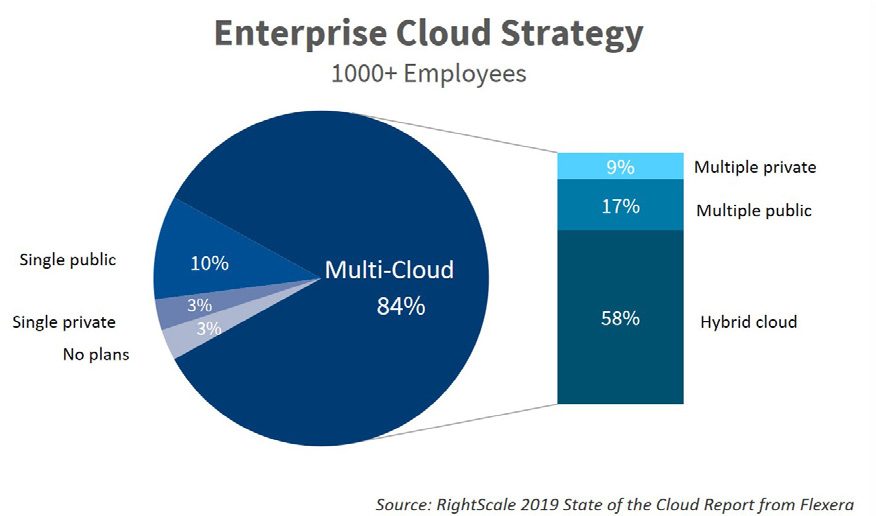If you’re like most enterprises – 84 percent – are reconsidering their enterprise architecture and adopting a hybrid cloud strategy, combining on-premises systems with public clouds, private clouds, or a mix of each, as the below chart from a recent Flexera report illustrates.
The main benefit of hybrid clouds is agility. Enterprises need to be able to quickly adapt and redirect their IT to remain competitive. Hybrid cloud offers the best of all worlds — the cost optimization, agility, flexibility, scalability and elasticity benefits of public cloud, and the control, compliance, security and reliability of private cloud and on-premises environments.
For example, it’s unlikely that an enterprise will build and maintain big-data processing capabilities on premises or in a private cloud because they require a lot of resources and aren’t always needed, at least not to the same degree as other systems. Instead, they can use public cloud big data analytics resources, scaling up and down as necessary, while using a private cloud to ensure data security and keep sensitive big data behind the corporate firewall.
Solace has been working with many of its enterprise customers to modernize their architecture and make the most of their hybrid cloud strategy. What follows are five common uses cases and how Solace can help.
1. Migrating existing on-premises functional workloads to cloud (a.k.a. lift-and-shift)
Many enterprises move on-premises IT workloads to the cloud to save money, be more flexible or to improve security. The advantage of migrating existing applications over building from scratch is it allows applications to be moved quickly and easily without having to re-architect them, but it still requires a lot of planning to ensure data sets will be matched with handling systems in the new environment and applications have the resources they need to operate effectively.
For example, when you have systems on premises that are already set up to communicate with one another – say through an enterprise service bus – and then lift-and-shift some of them to the cloud, how does this work?
Because PubSub+ Event Broker works both on premises and in the cloud, your application’s event routing doesn’t have to be rewritten when the application is rehosted; just point it to the local event broker in the cloud, which will ensure all events are dynamically routed to where they need to go.
2. Enhancing existing on-premises applications with cloud-native services
Organizations have invested in core systems of record for decades, many of which will never be suitable for cloud hosting. But many of those systems of record need to exchange data with services that include traditional datacenter resources, newer workloads deployed in the cloud, SaaS services, and a myriad of third-party services.
For example, an enterprise may want to stream data from a Kafka-based application to Google Cloud Platform for analytics. Solace has all the integration tools in place to make that possible. We have Kafka source and sink connectors to link your Kafka cluster to an on-premises Solace PubSub+ Event Broker, and once your data gets to the cloud, we offer an Apache Beam/Solace I/O connector so you can use the various Google data runners and repositories to get your data into the Google AI platform.
The same goes for other on-premises applications and cloud environments; we can securely connect to cloud native services like data lakes in GCP, AWS, and Azure with native integration between our event broker using REST, and have developed more robust connectors for Kafka, Apache Beam, Databricks, Apache Spark, and the AWS API Gateway. When combined with our event brokers – which support protocols including JMS, AMQP, MQTT, HTTP and WebSocket – we can connect just about any on-premises application to the most popular cloud native services in a low-code/no code fashion.
3. Faster application development
As organizations have embraced DevOps and agile methodologies, IT teams are looking for ways to speed up the development process. They use a public cloud to set up and do application development, because it’s very simple and easy to use, so you can get started quickly. But once applications are ready to deploy in production, enterprises may move them back to the on-premises data center for data governance or cost reasons.
The hybrid cloud model makes it possible for an organization to meet its needs for speed and flexibility in development, as well as its needs for stability, easy management, security, and low costs in production.
If your DevOps team is using cloud resources to build an application for speed, simplicity and low cost, you can use PubSub+ Event Broker: Software brokers or PubSub+ Event Broker: Cloud, our SaaS, in any public or private cloud environment.
And if you’re moving an application to an on-premises datacenter when going into production for security purposes, you can simply move the application without having to rewrite the event routing. It’s just like the lift-and-shift use case described above, but in reverse.
4. Enabling cloud-to-cloud integration
Many enterprises are using services from multiple cloud service providers to do things like avoid lock-in or to attain different functional advantages from different cloud providers, because each offers different best-of-breed cloud-native services. For example, AWS is known for their cheap S3 bucket, Google is widely thought to be the leader in analytics, and Azure has easy-to-use IoT infrastructure. Some organizations may want to use a mix of these resources and will need to be able to easily exchange information between them all. Additionally, because cloud providers offer different capabilities in different regions of the world, and because of data residency requirements, international enterprises might need resources from multiple cloud providers that varies depending on the region.
If you’re adopting a multi-cloud architecture, a PubSub+ powered event mesh extends into all of the popular public clouds, both within their public compute resources, as well as within the virtual private clouds offered by those providers, either using our software or our SaaS offering. And as mentioned, we can connect to many of the popular cloud native services, like Databricks, Apache Spark, and others.
5. Hybrid cloud event-driven microservices
To be more agile and to better manage scalability, reliability and availability, many enterprise applications are moving from monolithic architectures, where single applications are responsible for all aspects of a workflow, to microservices, which decompose the monolithic applications into smaller chunks of code. Those microservices then notify each other of changes using events. Microservices can be located wherever makes the most sense, on premises, in public or private clouds, or in PaaS or IaaS environments. And, as with application development, microservice app development can often start within a cloud environment and then be migrated elsewhere for production.
As Gartner points out, “Event-driven architecture (EDA) is inherently intermediated and implementations of event-driven applications must use some technology in the role of an event broker.”* This means you absolutely need an event broker underpinning your event-driven microservices architecture to make it work.
If those microservices are distributed across cloud and on-premises environments, it makes sense to have a robust and scalable broker that can connect to those microservices no matter where they are hosted or how they are run – on prem, on public or private clouds, in Spring, Kubernetes, OpenShift, as a Boomi Atom – the list goes on. In every case, Solace PubSub+ has you covered with native deployments or integrations that can all be connected with an event mesh, and will support the easy movement of microservices between hosting environments, as required.
Summary – Making the Most of Your Enterprise Architecture and Hybrid Cloud Strategy
In summary, hybrid and multi-cloud IT is now the norm for most large enterprises. But taking advantage of all the benefits of having data and applications on premises and in the clouds and sharing information between all the environments can be a tricky business. Thankfully, Solace has already done a lot of the heavy lifting for you and is always thinking of ways to make enterprise-wide event distribution as robust, secure and powerful as possible.
I’ve shared some of the most common hybrid cloud use cases our customers are asking us to address with our PubSub+ Platform. If you’d like to learn more about how to make the most of your enterprise architecture and hybrid cloud strategy, or have a specific example you’d like to discuss, we’d love to hear from you.
*Gartner, Innovation Insight for Event Brokers, Yefim Natis, Keith Guttridge, W. Roy Schulte, Nick Heudecker, Paul Vincent, 31 July 2018
Explore other posts from categories: Business | For Architects

 David Charles
David Charles

